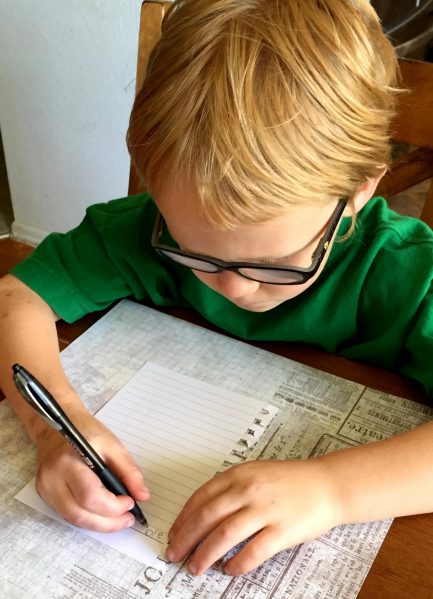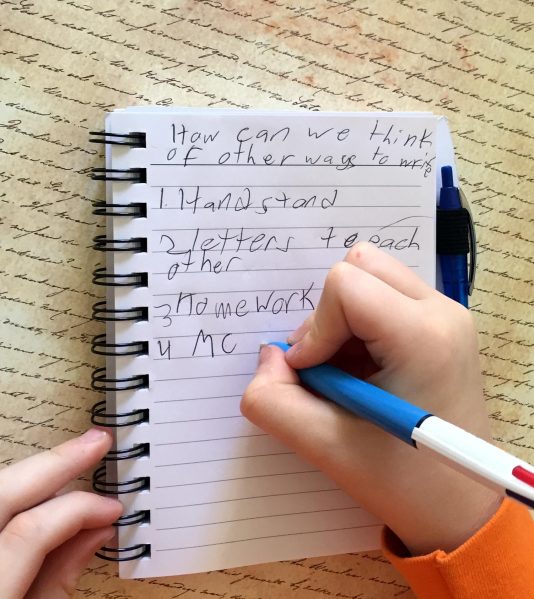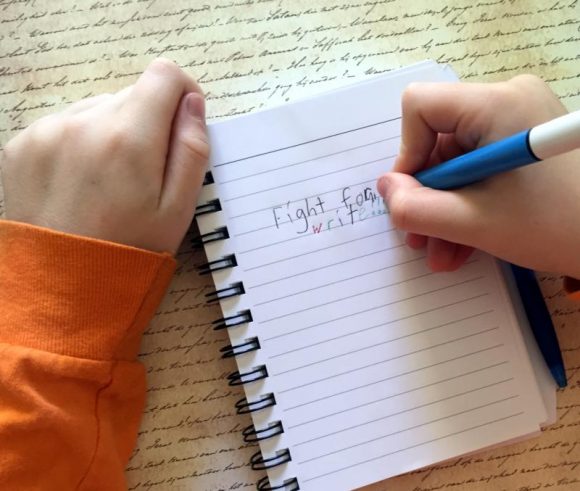
Good handwriting is one of those things that catches people’s attention. When I was a kid, I spent so much time practicing my handwriting – figuring out how I wanted to write my a’s (with or without that little swoopy thing on the top?) and how I wanted to dot my i’s (open circle, heart, or just a dot?), and I went through the entire alphabet writing and re-writing letters until I decided my own personal way I was going to write every letter.
And that’s the thing about handwriting: it’s as individual as a fingerprint. That is, if you use your handwriting. According to a study, as many as 75% of students grades 4-12 were writing below grade level on a national handwriting exam.
Handwriting is more than an art that we are losing; it’s essential for all areas of life: college studies, being a part of the workforce, and basic communication.

Fight for Your Write!
BIC has identified writing as an area that is worth maintaining, and has created the Fight for Your Write pledge, which is a promise to encourage handwriting around the home.
Take BIC’s Fight for Your Write pledge to save handwriting and enter for a chance to win a $1,200 BIC Prize Pack by visiting www.BICFightForYourWrite.com.

Just 15 minutes of handwriting practice a day can have dramatic results.
Did you know:
- Writing helps foster creativity
- Writing can help improve critical thinking skills
- Writing boosts self-confidence
- Better writers make better readers
- Writing helps improve school performance
- Writing sparks creativity
- Writing increases critical thinking skills
How to Make Handwriting More Fun for Kids
Some kids will naturally practice their handwriting more (like I did), and some will do anything to get out of writing. What can we, as parents and teachers, do to encourage kids to practice handwriting and penmanship, and how can we make it more fun? Here are six suggestions:

1. Set Aside Dedicated Time for Writing
Make it a family event! Writing turns into quality time when you turn off screens, and sit down at the kitchen table (or a writing desk!) for 15 minutes of uninterrupted writing time. Practice writing for 15 minutes every day, if possible. Set the timer and then get to writing! If kids know that everyone is taking a break from their day to write, they will be more willing to participate in this family (or classroom) event.
Not sure what to write? How about:
2. Write Letters to Each Other
Kids love to get mail. And the best way to get mail is to send mail first. Kids can send letters to grandparents, cousins, or a friend in another state. Or find a new penpal in another state or even a foreign country.

3. Write in a Family Journal
One journal, one family. Every day, one person from the family is in charge of writing down today’s family journal entry. It can include what the family has been up to today, any funny stories from today, or other notable news. This concept would work for a Classroom Journal as well.
Another angle on the family journal is a “call and response” style of writing: family members write letters to each other inside the journal, and then answer each other in the journal as well. In my experience, kids really enjoy this back and forth exchange.
4. Use Colorful Writing Tools
To add interest to the daily writing sessions, provide colorful pens and pencils, or a fun 4-color mechanical pen. These pens should be used ONLY for this writing session time slot. Use a colorful journal that the child can decorate with stickers or drawings.

5. Write Stories, Scripts, or Screenplays
Kids love to express themselves. Help channel these creative expressions into writing. Encourage children to write down the stories they tell you in a journal. They can write puppet shows, skits, or video scripts. These endeavors help engage active and creative kids in writing. My children are constantly talking about video games, so I encourage them to write stories down about their video games, or write scripts for videos they want to make.
6. Earn Rewards for Writing
Kids might be motivated to write for 15 minutes a day if there are some very small rewards offered. At the end of every 15 minutes (or one page of writing, etc.), the child can earn a sticker to put on her writing notebook or on a chart. Other small rewards can be found at the dollar store — you know what motivates your child best! When a child (or the family) has earned a certain number of stickers or marks on a chart, they could earn a larger prize, like a family excursion or game night.

Are you fired up to get writing? Take BIC’s Fight for Your Write pledge to save handwriting and enter for a chance to win a $1,200 BIC Prize Pack by visiting www.BICFightForYourWrite.com.
This is a sponsored conversation written by me on behalf of Bic. The opinions and text are all mine.





